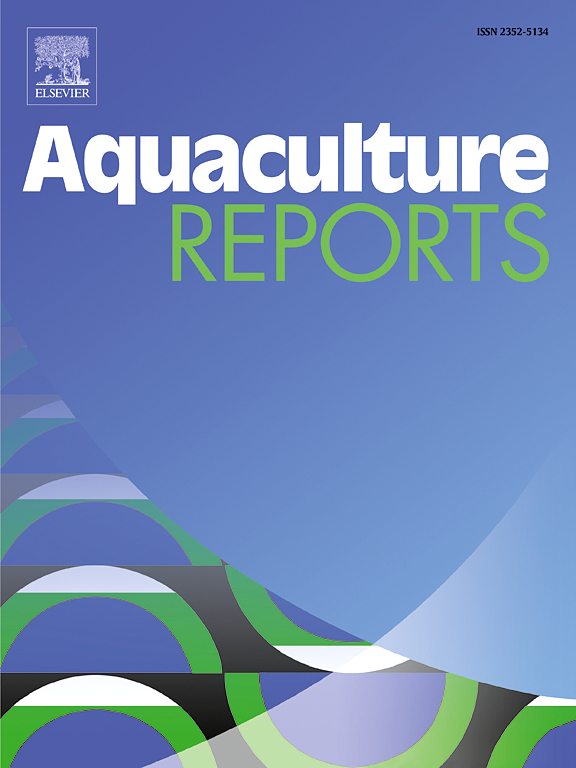蚕蛹粉对鳜鱼生长性能、肌肉脂肪酸组成和肠道功能的影响
IF 3.2
2区 农林科学
Q1 FISHERIES
引用次数: 0
摘要
本研究考察了蚕蛹粉(SWP)对鳜鱼生长性能、肌肉脂肪酸组成和肠道功能的影响。将 360 尾鱼(初始体重为 52.44 ± 0.06 克)随机分为三组,每组三个重复,每个重复 40 尾鱼。三组分别投喂基础饲料、添加 1.0 % 发酵过的 SWP(T1)或添加 1.0 % 发酵过的诱导 SWP(T2,由 Beauveria bassiana 诱导)。结果表明,饲喂 T1 的鱼的条件因子、C16:0、C20:4n-6、C20:5 n3、C22:6n3、C22:5n6、C22:5n-3 和 n-3/n-6 水平明显高于饲喂基础饲料的鱼(P <0.05),但脂肪体比率、C18:1、C18:2n-6 和粗脂肪水平低于饲喂基础饲料的鱼(P <0.05)。所有鱼类的增重率、特定生长率、饲料转化率、摄食量和肝脏指数相似(P >0.05)。饲喂 T2 的鱼的胰蛋白酶活性比饲喂基础日粮的鱼高(P < 0.05)。与基础日粮相比,饲喂 T1 或 T2 的鱼的绒毛长度、肌层厚度、谷胱甘肽过氧化物酶、碱性磷酸酶和溶菌酶活性更高(P < 0.05),但甘油三酯和总胆固醇水平较低(P < 0.05)。转录组比较分析表明,T1或T2能增强免疫和脂质代谢能力,表现为il12rb1、scdb、tlr2和FABP7的表达上调,EBP和hsd17b7的表达下调。这些研究结果表明,通过膳食补充发酵的西南太平洋鱼粉可以提高鳜鱼的健康水平和质量,为提高水产养殖产量提供了一种有价值的策略。本文章由计算机程序翻译,如有差异,请以英文原文为准。
Effects of silkworm pupae powder on growth performance, muscle fatty acid composition, and intestinal function in mandarin fish (Siniperca chuatsi)
This study examined the effects of dietary silkworm pupae powder (SWP) supplementation on the growth performance, muscle fatty acid composition, and intestinal function in mandarin fish (Siniperca chuatsi) during a 60-day feeding trial. A total of 360 fish (initial body weight 52.44 ± 0.06 g) were distributed randomly into three groups with three replicates per group and 40 fish per replicate. The three groups were fed either the basal diet, supplementation with 1.0 % fermented SWP (T1), or supplementation with 1.0 % fermented induced SWP (T2, induced by Beauveria bassiana). Results showed that fish fed T1 had significantly higher (P < 0.05) condition factor, C16:0, C20:4n-6, C20:5 n3, C22:6n3 C22:5n6, C22:5n-3, and n-3/n-6 levels, but lower (P < 0.05) fat body ratio, C18:1, C18:2n-6 and crude lipid levels than those fish fed basal diet. All fish had similar (P > 0.05) weight gain rate, specific growth rate, feed conversion rate, feed intake, and hepatosomatic index. Fish fed T2 had higher (P < 0.05) trypsin activity than those fish fed basal diet. Compared with the basal diet, fish fed T1 or T2 had higher (P < 0.05) villus length, muscular layer thickness, glutathione peroxidase, alkaline phosphatase, and lysozyme activities, but lower (P < 0.05) triglyceride and total cholesterol levels. Comparative transcriptomic analysis indicated that T1 or T2 enhanced immunity and lipid metabolism ability, as manifested in the up-regulated expression of il12rb1, scdb, tlr2, and FABP7, and the down-regulated expression of EBP and hsd17b7. These findings suggest that dietary supplementation with fermented SWP could enhance the health and quality of mandarin fish, potentially offering a valuable strategy for improving aquaculture productivity.
求助全文
通过发布文献求助,成功后即可免费获取论文全文。
去求助
来源期刊

Aquaculture Reports
Agricultural and Biological Sciences-Animal Science and Zoology
CiteScore
5.90
自引率
8.10%
发文量
469
审稿时长
77 days
期刊介绍:
Aquaculture Reports will publish original research papers and reviews documenting outstanding science with a regional context and focus, answering the need for high quality information on novel species, systems and regions in emerging areas of aquaculture research and development, such as integrated multi-trophic aquaculture, urban aquaculture, ornamental, unfed aquaculture, offshore aquaculture and others. Papers having industry research as priority and encompassing product development research or current industry practice are encouraged.
 求助内容:
求助内容: 应助结果提醒方式:
应助结果提醒方式:


